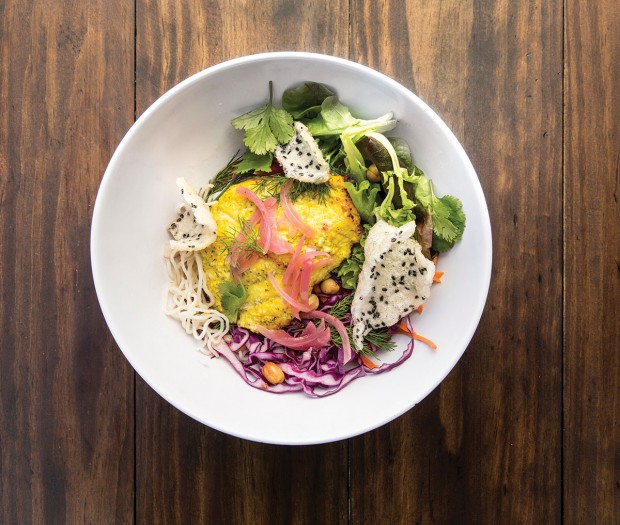Dining trends to devour


Chef Chris Shepherd’s translation of Vietnamese cha ca is served on a bed of rice noodles and made with roasted turmeric-kissed snapper tossed with fresh dill and peanuts. (Photo: Julie Soefer)
A decade ago, the hottest trend was bite-sized desserts and locally grown, organic produce. The ethnic-cuisine idol of the moment was Latin-America. Diners latched onto Argentinian steaks and Peruvian ceviche. Now flash-forward to 2016, and the rising star is Korean – from barbecue short ribs to garlicky fried chicken.
Seoul inspiration is taking root not only at Korean fried chicken outlets, including Dak & Bop (1801 Binz) and Republic Diner + Sojubang (1221 W. 11th Street), but in trendy New American restaurants, such as the popular “K-town,” twice-fried chicken with pickles at State of Grace (3258 Westheimer) and the Korean braised goat and dumplings at Underbelly (1100 Westheimer). The Korean goat dish outsells his second best-seller two to one, said Underbelly chef-owner Chris Shepherd. What other trends can we expect to see on spring menus?
Korea is on the radar, but Shepherd is exploring what might be the next big thing – Vietnamese. With the third largest Vietnamese population in the United States, Houstonians “are familiar with Vietnamese food, but the rest of the country has yet to explore it. I’m going to push Vietnamese really hard because of where we are. And besides, I love it. It’s a beautiful, vibrant cuisine,” said Shepherd. Of the 20 dishes he served on a recent night, five were Vietnamese, including roasted snapper cha ca fragrant with turmeric and fresh dill.
Locally sourced meats and seafood top the list of hot trends, along with novel cuts of meat, like pork collar. Less common cuts of steak and pork are taking diners beyond the porterhouse. “People are utilizing every part of the animal,” said Pearland chef Ronnie Killen, who sears and serves bone-in pork belly and tri-tip steak. While popular among Californians, the triangular cut of the bottom sirloin is under the radar in Texas, added the owner of Killen’s Steakhouse (6425 W Broadway) and Killen’s Barbecue (3613 E. Broadway).
Salmon and tuna may top sushi menus. But there are other catch, and chef Addison Lee of Kuu (947 Gessner Road) wants Houstonians to get into the habit of eating sushi by the season. So along with the usual suspects, he’s highlighting Spanish mackerel, baby snapper, octopus and abalone in the spring. Come summer, amberjack swims to the head of the class. “Every season has its best catches. As diners become more educated about sushi, they want a stronger focus on seasonality as well as regionality,” he said.
When the global economy wanes, chefs revert to the classics. A great bowl of bolognese provides great comfort, said Mark Cox of Mark’s American Cuisine (1658 Westheimer). These days, he pointed out, star chefs, including Daniel Boulud and Mario Batali, prefer to hone and finesse familiar, comfort dishes. Diners want simplicity, but they also want to be tantalized, so even a rustic lamb shank takes on a multiplicity of elegant textures and flavors when Cox tosses it with finely diced potatoes to make a hash to stuff into tender crepes. No matter what the trend, he said, diners want a cohesive experience that delights them.A decade ago, the hottest trend was bite-sized desserts and locally grown, organic produce. The ethnic-cuisine idol of the moment was Latin-America. Diners latched onto Argentinian steaks and Peruvian ceviche. Now flash-forward to 2016, and the rising star is Korean – from barbecue short ribs to garlicky fried chicken.
What’s hot in 2016?
Here are the top 20 trends, based on a survey of nearly 1,600 chefs.
• Locally sourced meats and seafood
• Chef-driven, fast-casual concepts
• Locally grown produce
• Hyper-local sourcing
• Natural ingredients/minimally processed food
• Environmental sustainability
• Healthful kids’ meals
• New cuts of meat
• Sustainable seafood
• House-made/artisan ice cream
• Ethnic condiments/spices
• Authentic ethnic cuisine
• Farm-/estate-branded items
• Artisan butchery
• Ancient grains
• Ethnic-inspired breakfast items
• Fresh/house-made sausage
• House-made/artisan pickles
• Food waste reduction/management
• Street food/food trucks
Source: National Restaurant Association
Want more buzz like this? Sign up for our Morning Buzz emails.
To leave a comment, please log in or create an account with The Buzz Magazines, Disqus, Facebook, or Twitter. Or you may post as a guest.


